-
The journey of nuclear power, from its conception in 1895 all the way to its last major restriction put in place, is riddled with rough spots along the way where our world faced serious damages. Now this has happened all over the world. The two largest nuclear powers, the US and the Soviet Union, both have faced this issue. The damage caused by nuclear power has not just been an instance of ignorance or accident. Continued in Part 6->
-
There have been constant issues that have come from humans attempting to use nuclear power, and the side effects of these issues have never happened quietly. These effects have gone straight into our atmosphere and even destroyed whole environments to the point where it was uninhabitable by humans. Continued in part 7->
-
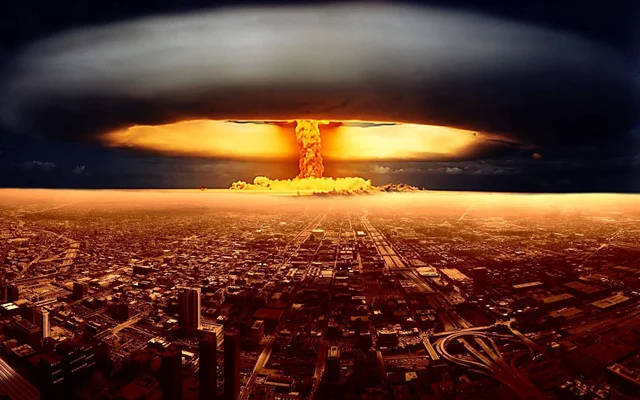 In 1895 Nuclear Power was invented¹. This came through Wilhelm Rontgen discovering the process of Ionizing Radiation². The ionization of this radiation would set humanity on a path of great destruction and power. Some could say the path we were set on was nuclear...sorry, that isn't funny. In all reality, the raw power of nuclear energy came to be when humans figured out how to split the atom. They do this by bombarding the atoms of different elements with protons. Continued on part 2->
In 1895 Nuclear Power was invented¹. This came through Wilhelm Rontgen discovering the process of Ionizing Radiation². The ionization of this radiation would set humanity on a path of great destruction and power. Some could say the path we were set on was nuclear...sorry, that isn't funny. In all reality, the raw power of nuclear energy came to be when humans figured out how to split the atom. They do this by bombarding the atoms of different elements with protons. Continued on part 2-> -
As rival governments grow their nuclear power to stay on top, the threat of damage to our world has only grown with it. In modern times, the usage of nuclear power has grown to be very sophisticated. Nuclear reactors generate about 20% of all of the electricity used in the United States⁴. They do this because nuclear power does not directly use any fossil fuels. Outside of the risks of mass destruction, nuclear power is very effective. Continued in part 4->
-
The resulting split in atoms, from the bombardment, causes a release of about 200 million electron volts³. This process is called fission. Now, this all sounds great until you think about the unintended consequences of this release of 200 million electron volts. Since its creation, nuclear power could light more and more homes, and nuclear power could destroy more and more homes. Continued in part 3->
-
However, the sad truth is, that there has been nuclear destruction on Earth. Governments have not been able to control the chaos of nuclear fission in their pursuit of more power. Factories have melted down, protests throughout the 1900s called for an end to nuclear power, and remedies have been put in place a little too late. Continued in P5->
-
The path that nuclear energy traveled in the United States has been well documented. Its advances have been known, but its shortcomings and fallbacks have gone way more noticed. These have been noticed by the angry people who disagree with the government and the government itself is being viewed from the world stage. This timeline follows the path of the problems nuclear power has caused the United States and the havoc wreaked on in environments.
-
 The Nuclear Test Ban Treaty was signed into international law under the United Nations Assembly to limit the testing of nuclear power in the atmosphere, underwater, and in Outer Space. The treaty was signed by representatives of the United States, Great Britain, and the Soviet Union. In the image above⁶ Kennedy is signing the treaty due to outcries from the people of their fears of global damage that could come if nuclear power continued to be used on our planet. Continued in Part 2->
The Nuclear Test Ban Treaty was signed into international law under the United Nations Assembly to limit the testing of nuclear power in the atmosphere, underwater, and in Outer Space. The treaty was signed by representatives of the United States, Great Britain, and the Soviet Union. In the image above⁶ Kennedy is signing the treaty due to outcries from the people of their fears of global damage that could come if nuclear power continued to be used on our planet. Continued in Part 2-> -
This treaty would go down as the first worldwide effort to restrict nuclear power. Also, it would later have profound effects on the events of the Cold War as Russia challenges the US in the nuclear arms race.
-
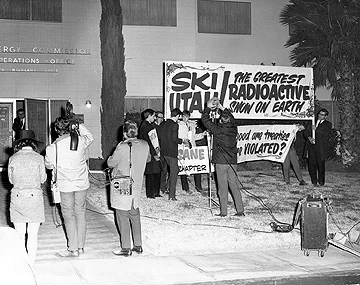 The image above⁷ depicts the protests that took place outside of the Atomic Energy Commission (AEC). These protests were popularly begun in the 1960s and only grew as nuclear power grew. The protestors were gathering in the name of anti-nuclear power. Keep in mind, that the United States just unleashed the power of nuclear energy on Hiroshima. Continued in part 2->
The image above⁷ depicts the protests that took place outside of the Atomic Energy Commission (AEC). These protests were popularly begun in the 1960s and only grew as nuclear power grew. The protestors were gathering in the name of anti-nuclear power. Keep in mind, that the United States just unleashed the power of nuclear energy on Hiroshima. Continued in part 2-> -
The destruction that nuclear energy was capable of was apparent to the people. Also, in the 1960s activists were hammering the government out of environmental concerns, so naturally, protestors found their way to the doorstep of the AEC to demand restrictions on nuclear energy. The fear of destruction and the environmental effects outweighed the possible benefits of the energy. Continued in part 3->
-
Eventually, the AEC would be split into two separate agencies in 1974⁸ because the AEC could not effectively control the waste of nuclear energy. This waste was harmful to our environment as it emits 10,000 rem/hours of radiation, vastly greater than the fatal 500 rem/hours human can take⁹.
-
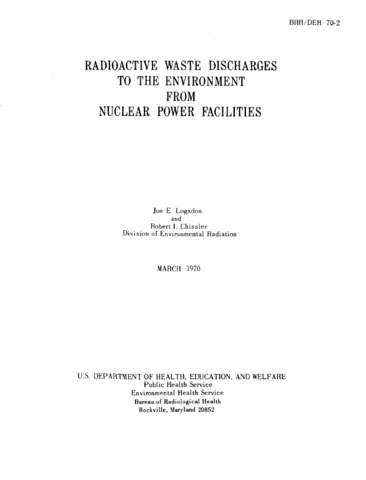 A study done by nuclear specialists Joe E. Logsdon and Robert I. Chissler with the Division of Environmental Radiation is depicted above¹⁰. The study includes a foreword that states the whole purpose of the study. The purpose was to monitor the potential effect radiation that gets in the atmosphere from nuclear power could have on humans. Continued in part 2->
A study done by nuclear specialists Joe E. Logsdon and Robert I. Chissler with the Division of Environmental Radiation is depicted above¹⁰. The study includes a foreword that states the whole purpose of the study. The purpose was to monitor the potential effect radiation that gets in the atmosphere from nuclear power could have on humans. Continued in part 2-> -
It also shows the seriousness the government responded with to the anti-nuclear environmental activists. Interestingly, the results of the study were quite dramatic. For example, in the study, the scientist found that a boiling water reactor facility that went by the name of Humboldt Bay discharged 197,000 curies of waste in 1965¹¹. Continued in part 3->
-
For context, a curie is a unit of radioactivity, and one curie is equal to 37 billion transformations per second of the element being used. In other words, 1 curie is a lot. 197,000 curies of gaseous waste discharged from the reactor undoubtedly had a high impact on the environment around it.
-
It revealed the worst of nuclear energy. Three-mile Island also confirmed the fears of all the people who were scared of the usage of nuclear power. Most importantly, this accident signaled the need for change and restriction when it comes to wielding nuclear power for the benefit of not only the US but the whole world.
-
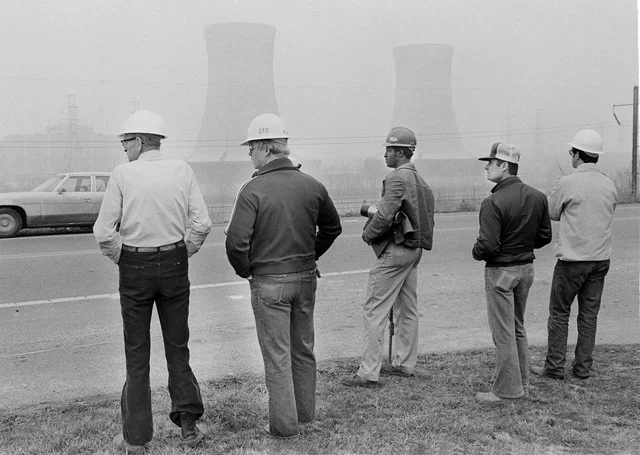 The image above¹² depicts 5 people who worked at the Three-mile Island nuclear facility standing far away from the site because the site was evacuated due to a meltdown in the nuclear reactor. In the background, the two stacks are burning with radioactive gas being discharged into the atmosphere. This was a sad day for the United States as, even still, it was the worst nuclear energy accident in the history of the United States. Continued in part 2->
The image above¹² depicts 5 people who worked at the Three-mile Island nuclear facility standing far away from the site because the site was evacuated due to a meltdown in the nuclear reactor. In the background, the two stacks are burning with radioactive gas being discharged into the atmosphere. This was a sad day for the United States as, even still, it was the worst nuclear energy accident in the history of the United States. Continued in part 2-> -
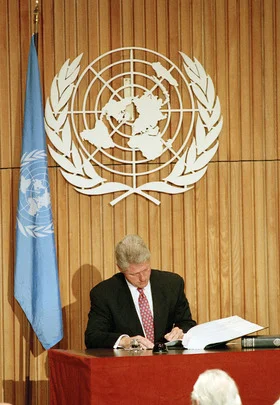 This image depicts Bill Clinton signing¹⁴ the Comprehensive Test Ban Treaty into effect that the UN had wanted to make official since 1973. This is a multilateral treaty signed at the United Nations General Assembly that made an attempt to prohibit nuclear explosions entirely. The aim of the treaty was to protect the militaries, civilians, and the environment all over the world. This treaty hoped to take a modern approach to global nuclear safety. Continued in part 2->
This image depicts Bill Clinton signing¹⁴ the Comprehensive Test Ban Treaty into effect that the UN had wanted to make official since 1973. This is a multilateral treaty signed at the United Nations General Assembly that made an attempt to prohibit nuclear explosions entirely. The aim of the treaty was to protect the militaries, civilians, and the environment all over the world. This treaty hoped to take a modern approach to global nuclear safety. Continued in part 2-> -
A ban was needed because the nuclear test ban treaty adopted in the '60s was ruined by the Cold War in the 1980s. The fear of nuclear power getting in the wrong hands by spreading to smaller countries was too great for the US to not act upon given the threat nuclear power had already posed to the country. The treaty is a sign of hope for every person and the future safety of our planet as it takes a step in the right direction to keep nuclear energy limited.
-
- Arif, Aayesha. “Here Is What You Should Do If a Nuclear Bomb Explodes Nearby.” Wonderful Engineering, May 25, 2017. https://wonderfulengineering.com/nuclear-bomb-explodes-nearby/.
- “Outline History of Nuclear Energy.” History of Nuclear Energy - World Nuclear Association, November 2020. https://www.world-nuclear.org/information-library/current-and-future-generation/outline-history-of-nuclear-energy.aspx.
- Ibid.
-
- “Nuclear Power Plants.” EPA, July 6, 2023.
https://www.epa.gov/radtown/nuclear-power-plants. - Senate., The Nuclear Test Ban Treaty § (1963).
- Editors, History.com, ed. “John F. Kennedy - Facts,
Presidency & Assassination.” History.com, October 9,- https://www.history.com/topics/us-presidents/john- f-kennedy#&pid=signing-the-nuclear-test-ban-treaty.
- “Nuclear Power Plants.” EPA, July 6, 2023.
-
- Hong, Lena. “American Anti-Nuclear Activism in the
1970s.” American anti-nuclear activism in the 1970s, June
1, 2016.
http://large.stanford.edu/courses/2016/ph241/hong1/. - Ibid.
- “Backgrounder on Radioactive Waste.” NRC Web,
January 26, 2024. https://www.nrc.gov/reading-rm/doc-
collections/fact-sheets/radwaste.html. - Logsdon, Joe E., and Robert I. Chissler, Radioactive Waste Discharges to the Enviroment from Nuclear Power Facilities § (1970).
- Hong, Lena. “American Anti-Nuclear Activism in the
-
- Ibid., 22.
- Wardle, Lisa. “Photos: A Look Back at the Three Mile Island Accident, Evacuations, Protests and Cleanup | Stateimpact Pennsylvania.” NPR, August 18, 2020. https://stateimpact.npr.org/pennsylvania/2019/03/21/photos-a-look-back-at-the-three-mile-island-accident-evacuations-protests-and-cleanup/.
- Senate., Comprehensive test ban treaty § (1995).
- United Nations Photo, September 24, 1996. https://www.unmultimedia.org/s/photo/detail/853/0085302.html.